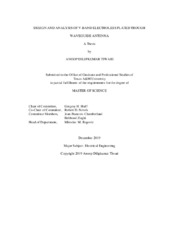| dc.contributor.advisor | Huff, Gregory H | |
| dc.contributor.advisor | Nevels, Robert D | |
| dc.creator | Tiwari, Anoop Dilipkumar | |
| dc.date.accessioned | 2020-08-26T20:03:27Z | |
| dc.date.available | 2020-08-26T20:03:27Z | |
| dc.date.created | 2019-12 | |
| dc.date.issued | 2019-11-06 | |
| dc.date.submitted | December 2019 | |
| dc.identifier.uri | https://hdl.handle.net/1969.1/188805 | |
| dc.description.abstract | Design feasibility and antenna element choices make linear antenna arrays a preferred choice for applications at frequencies above 1 GHz. However, restricted bandwidth and limited scanning capabilities reduce the usefulness of these arrays in certain applications. Travelling wave antennas can overcome these problems by varying the phase velocity inside the transmission line to provide a high bandwidth scanning capability. The main beam of such a travelling wave antenna is able scan from the nearendfire to the broadside region. However, the change in the angle of the main beam from endfire to broadside introduces a high impedance mismatch which causes attenuation and reflection losses in the antenna. This research explores impedance matching techniques which could enhance the performance of beam scanning systems by solving this problem. This work covers the design, fabrication, and testing of a V-band Trough waveguide antenna (TWA) which uses tuning elements inside the guide for each perturbation. Additionally, this research covers the design and fabrication of two types of waveguide transitions. One transition connects standard rectangular waveguide to a troughguide, and another transition converts circular waveguide to a troughguide. These transitions achieve the correct orientation of modes at the input of the trough waveguide for a proper operation of the antenna. The initial TWA design uses a rectangular base which is developed into a curved base for each channel in the final design. The curved base improves the fluid flow utilized in the fabrication process of TWA. The initial design used rectangular matching posts attain matching and reduce the reflections at the interface of each perturbation. The final designs used circular/hemispherical matching elements with dimensions based on the rectangular posts allowed smooth edges. The author analyzed tuning elements of various shapes to obtain impedance matching while ensuring the dimensions are viable on the 3D printer available. The next phase of the study investigated maximizing the efficiency and radiation characteristics of the antenna by maximizing the radiated power. Finally, the author attempts reduction in sidelobes of the antenna using amplitude tapering functions such as squared cosine and triangular window for the trough waveguide antenna. The resulting antenna achieves a narrow broadside beam which can be scanned for the entire V-band frequency. | en |
| dc.format.mimetype | application/pdf | |
| dc.language.iso | en | |
| dc.subject | Trough waveguide | en |
| dc.subject | mmWave antenna | en |
| dc.subject | 3D Printing | en |
| dc.subject | electroless silver plating | en |
| dc.subject | broadside pattern | en |
| dc.subject | impedance matching | en |
| dc.title | Design and Analysis of V-Band Electroless Plated Trough Waveguide Antenna | en |
| dc.type | Thesis | en |
| thesis.degree.department | Electrical and Computer Engineering | en |
| thesis.degree.discipline | Electrical Engineering | en |
| thesis.degree.grantor | Texas A&M University | en |
| thesis.degree.name | Master of Science | en |
| thesis.degree.level | Masters | en |
| dc.contributor.committeeMember | Zoghi, Behbood | |
| dc.contributor.committeeMember | Chamberland, Jean-Francois | |
| dc.type.material | text | en |
| dc.date.updated | 2020-08-26T20:03:28Z | |
| local.etdauthor.orcid | 0000-0001-9997-1517 | |


